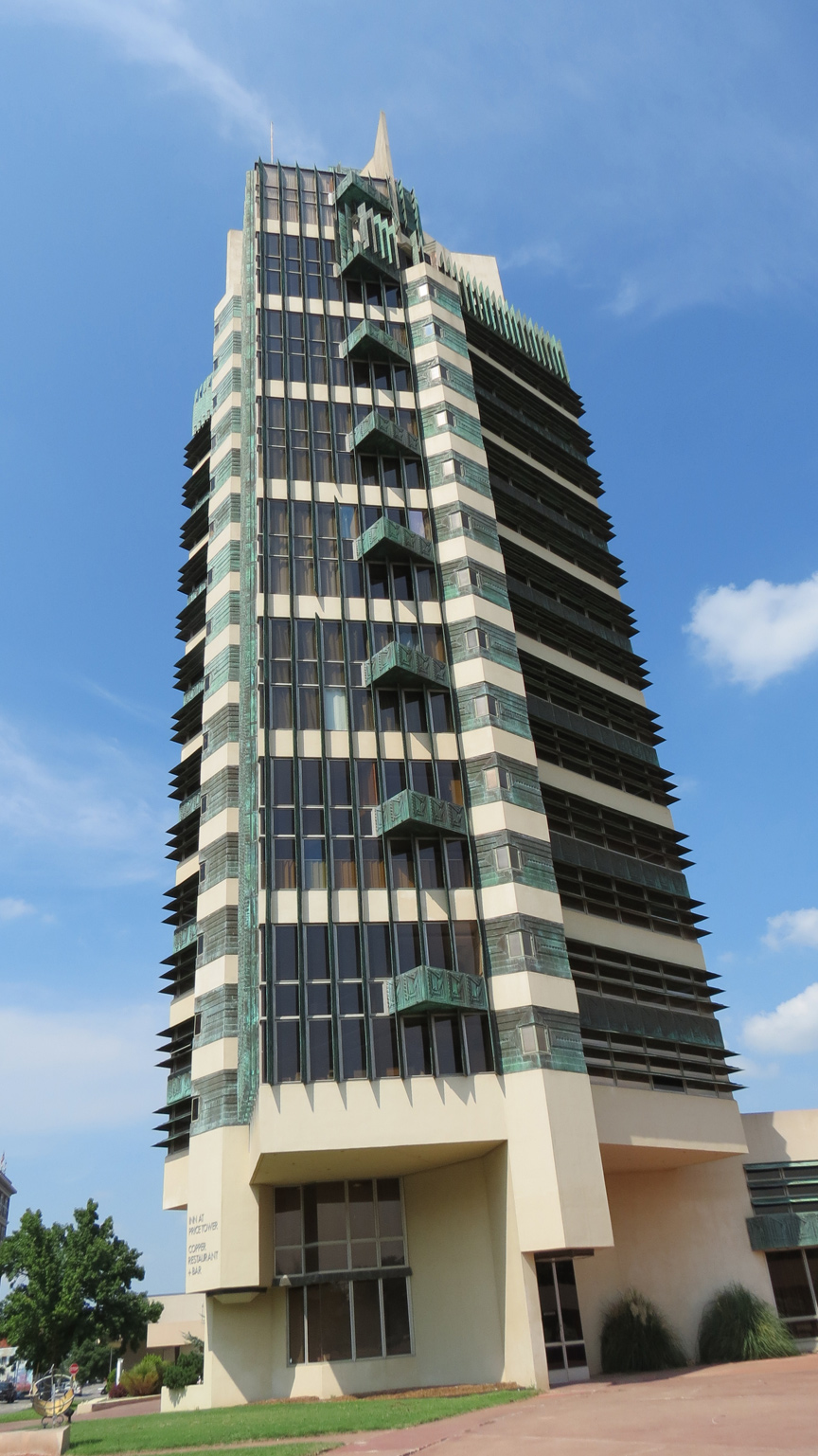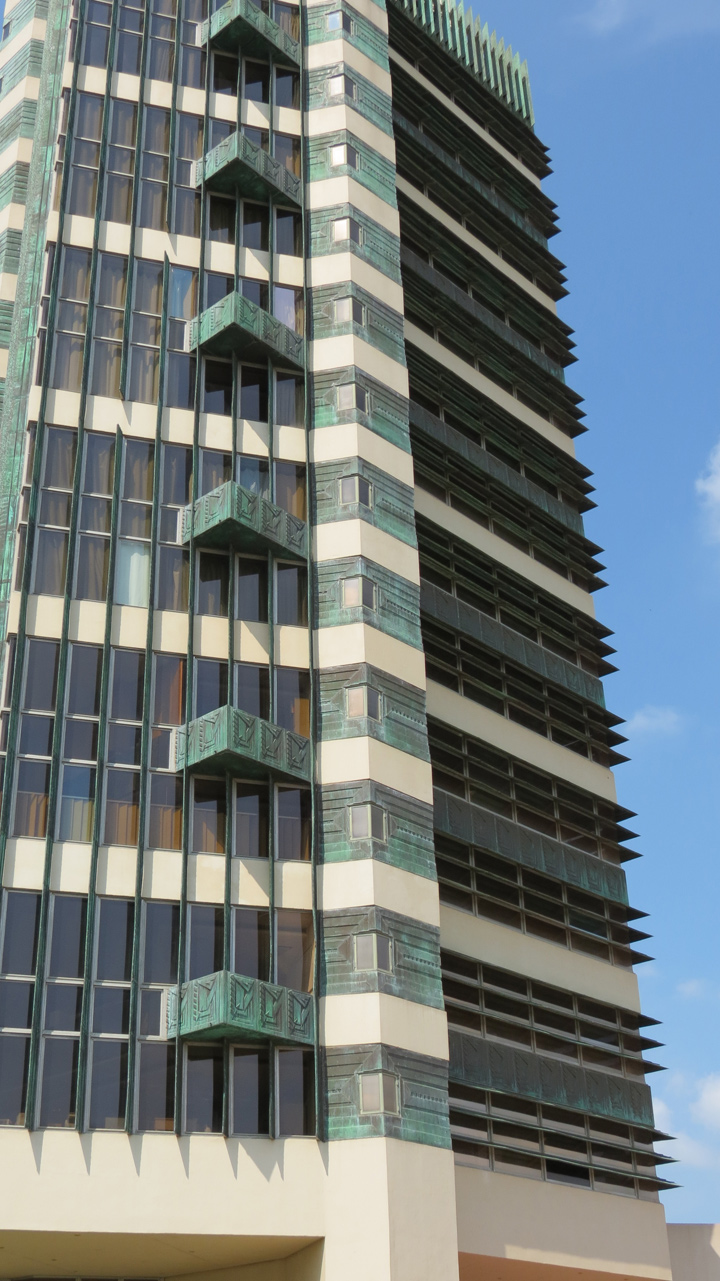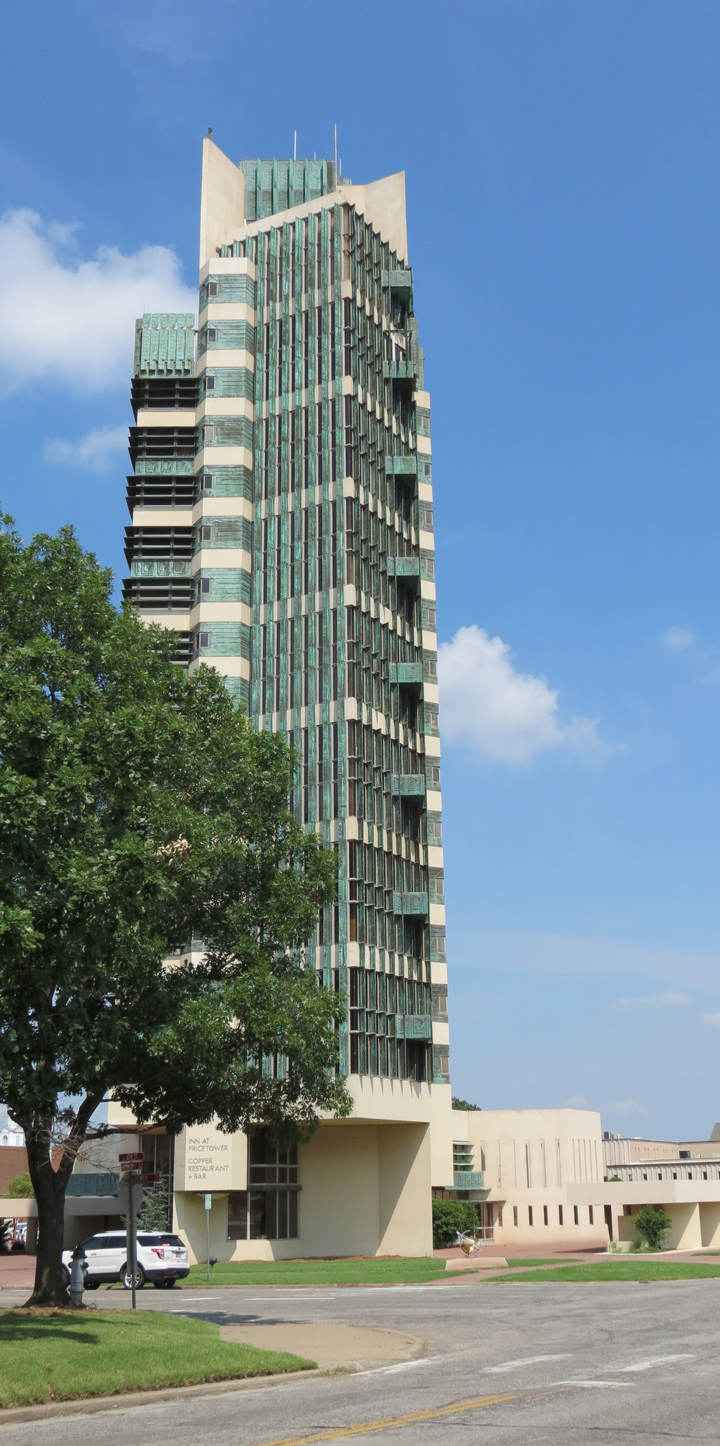

Price Tower
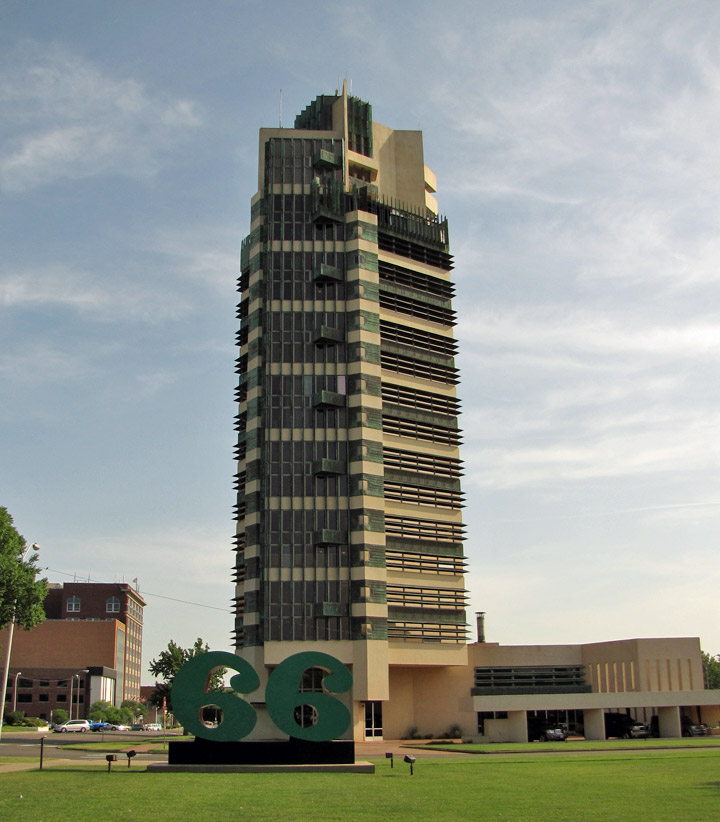
Price Tower
The Price Tower is a nineteen story, 221 foot high tower in Bartlesville, Oklahoma that was designed by Frank Lloyd Wright. It is the only realized skyscraper by Wright, and is one of only two vertically-oriented Wright structures extant (the other is the S.C. Johnson Wax Research Tower in Racine, Wisconsin).
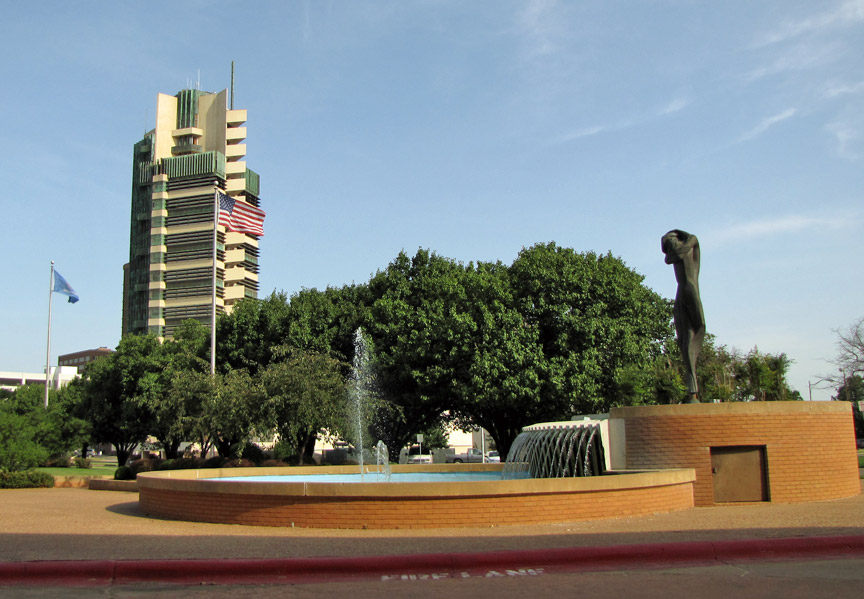
The Price Tower was commissioned by Harold C. Price of the H. C. Price Company,
a local oil pipeline and chemical firm. It opened to the public in February
1956.
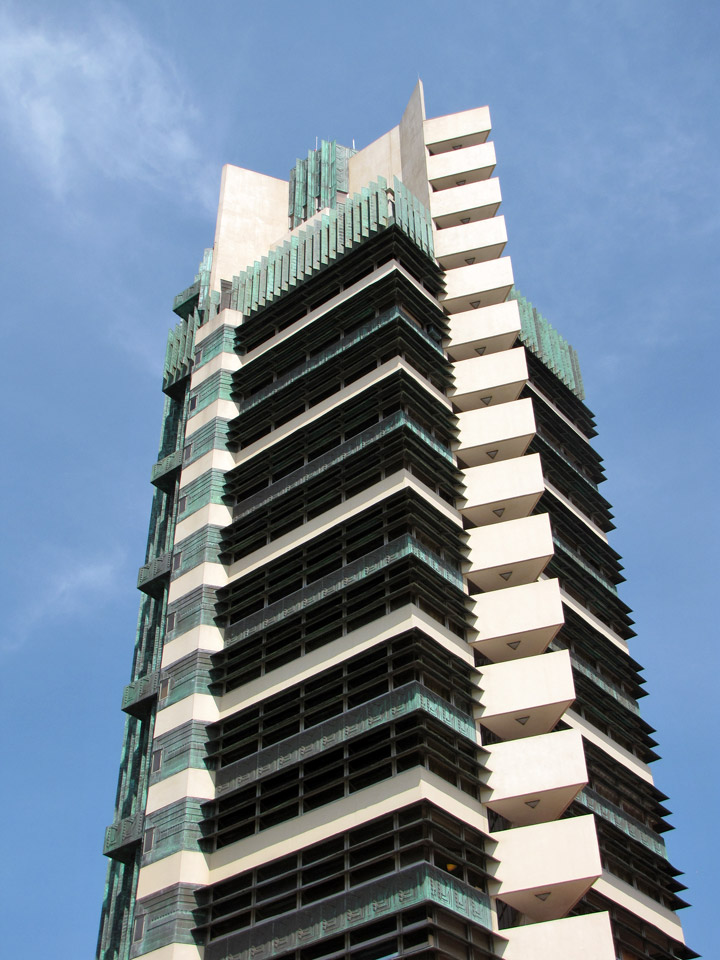
The Price Tower was commissioned by Harold C. Price, for use as a corporate
headquarters for his Bartlesville company. His wife, Mary Lou Patteson Price,
and his two sons, Harold, Jr., and Joe, rounded out the building committee. The
Prices were directed to Frank Lloyd Wright by architect Bruce Goff, who was then
Dean of Architecture at the University of Oklahoma, where the Price sons had
studied. That relationship bonded into a life-long patronage of both architects
by the Price Family. Wright designed an Arizona home for the senior Prices and a
Bartlesville home for Harold, Jr., his wife Carolyn Propps Price, and their six
children. Goff, who was also a tenant at Price Tower, became the favored
architect of Joe Price, designing a bachelor studio on his family's property in
Bartlesville and two later additions following his marriage to Etsuko Yoshimochi.
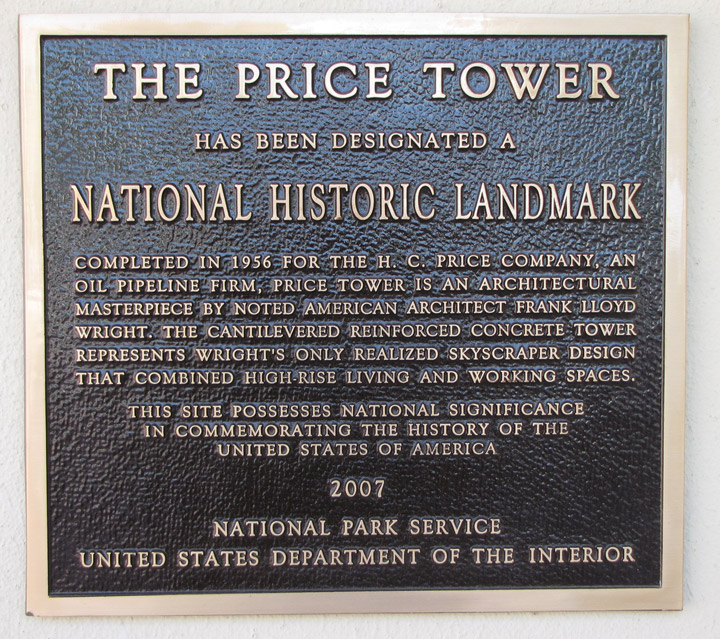
Wright nicknamed the Price Tower, which was built on the Oklahoma prairie, "the
tree that escaped the crowded forest," referring not only to the building's
construction, but also to the origins of its design. The Price Tower is
supported by a central "trunk" of four elevator shafts which are anchored in
place by a deep central foundation, as a tree is by its taproot. The nineteen
floors of the building are cantilevered from this central core, like the
branches of a tree. The outer walls hang from the floors and are clad in
patinated copper "leaves." Wright had championed these design ideas, which other
architects had put to use before the construction of the Price Tower as early as
the 1920s in his design for an apartment complex of four cantilevered towers for
St. Marks-in-the-Bowerie in downtown New York City. Following the effects of the
Great Depression, the project was shelved and adapted by Wright for the Price
Company in 1952. Wright, therefore, plucked his "tree" out of the "crowded
forest" of Manhattan skyscrapers and placed it on the Oklahoma prairie where it
continues to stand uncrowded by neighboring tall buildings.
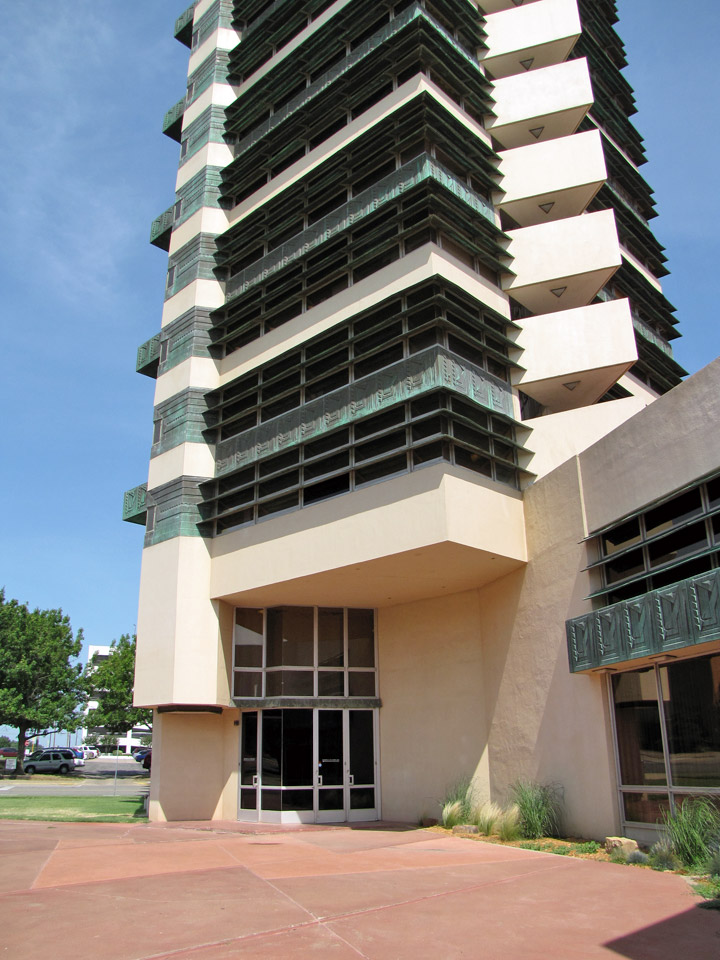
The floor plan of the Price Tower centers upon an inlaid cast bronze plaque,
bearing the logo of the Price Company and marking the origin of a parallelogram
grid upon which all exterior walls, interior partitions and doors, and built-in
furniture are placed. The resulting design is a quadrant plan—one quadrant
dedicated for double-height apartments, and three for offices. The materials for
the Price Tower are equally innovative for a mid-twentieth-century skyscraper:
cast concrete walls, pigmented concrete floors, aluminum-trimmed windows and
doors, and patinated embossed and disstressed copper panels. The general
geometric element is the equilateral triangle, and all lighting fixtures and
ventilation grilles are based upon that form while the angled walls and built-in
furniture are based on fractions or multiples of the triangular module.
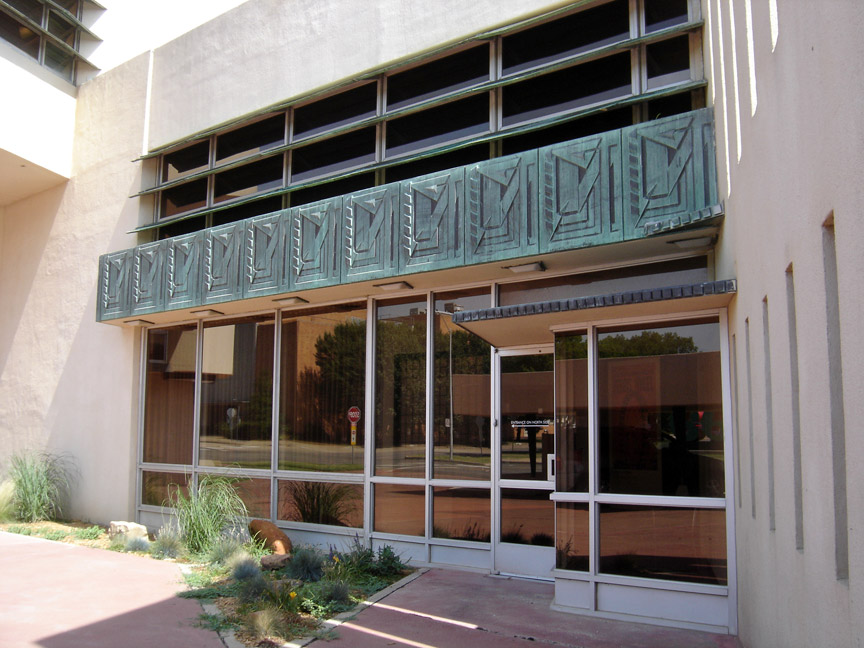
Wright designed the St. Mark's project for apartments, but his Price Tower was
to be a multi-use building with business offices, shops, and apartments. The H.
C. Price Company was the primary tenant, and the remaining office floors and
double-height apartments intended as income-raising ventures. Tenants included
lawyers, accountants, physicians, dentists, insurance agents, and the architect
Bruce Goff, who kept an office in the tower as well as rented one of the
apartments. A women's high-end dress shop, beauty salon, and the regional
offices of the Public Service Company of Oklahoma occupied a two-story wing of
the tower, with a drive-through passageway separating the high and low
structures. The Price Company occupied the upper floors, and included a
commissary on the sixteenth floor as well as a penthouse office suite for Harold
Price, Sr., and later his son, Harold, Jr.
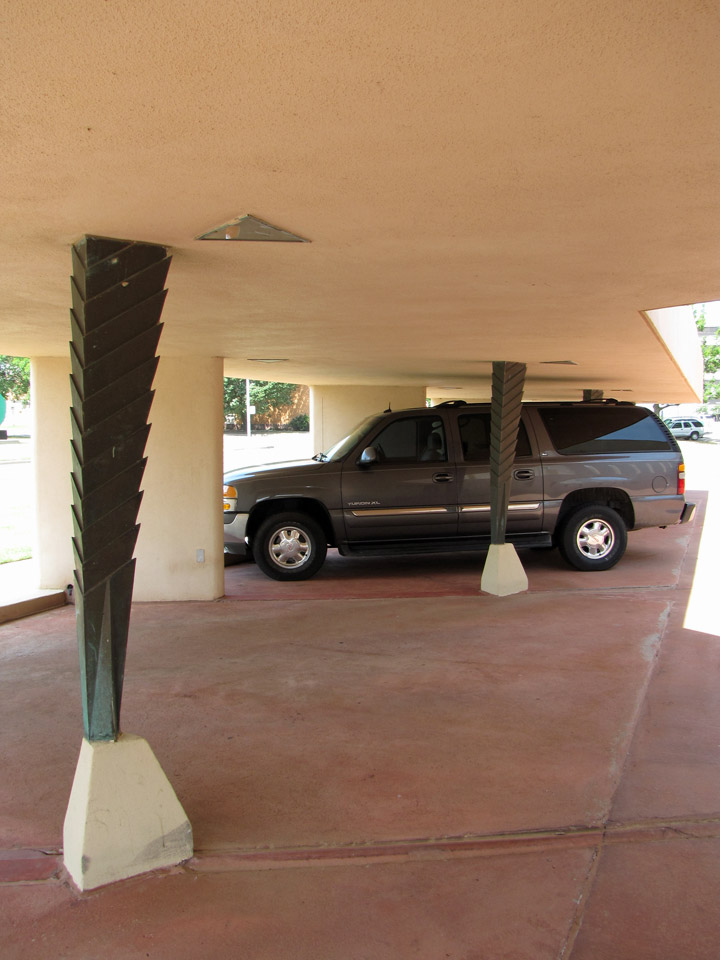
carport
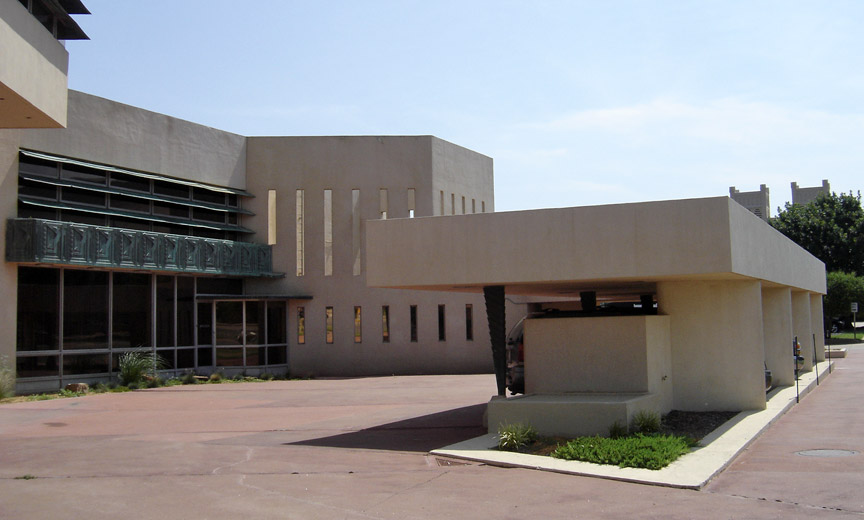
carport on the right
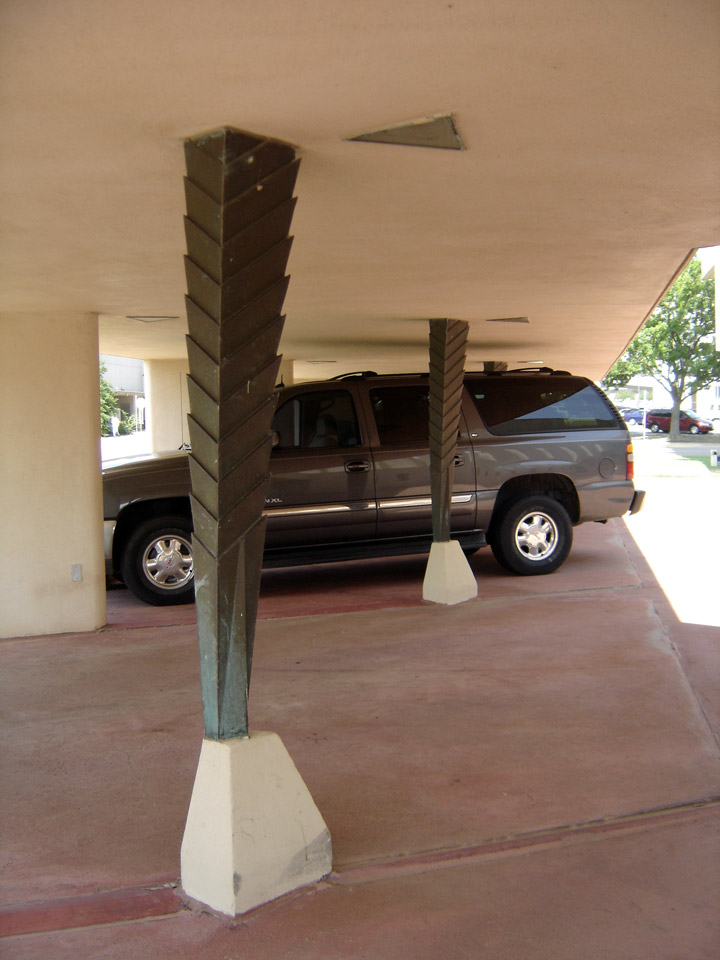
The H.C. Price Company sold Price Tower to Phillips Petroleum in 1981 following a move to Dallas, where their company is presently located. Phillips Petroleum retained ownership until 2000 when the building was donated to Price Tower Arts Center, and it has returned to its multi-use origins. Price Tower Arts Center, a museum of art, architecture, and design; Inn at Price Tower; Copper Restaurant + Bar, and the Wright Place museum store are the current major tenants with smaller firms leasing space. In 2002 Pritzker Prize winning architect, Zaha Hadid, was commissioned to design a museum expansion for Price Tower Arts Center—a project that was included in the 2006 retrospective exhibition of Hadid's work at the Guggenheim Museum, New York City.
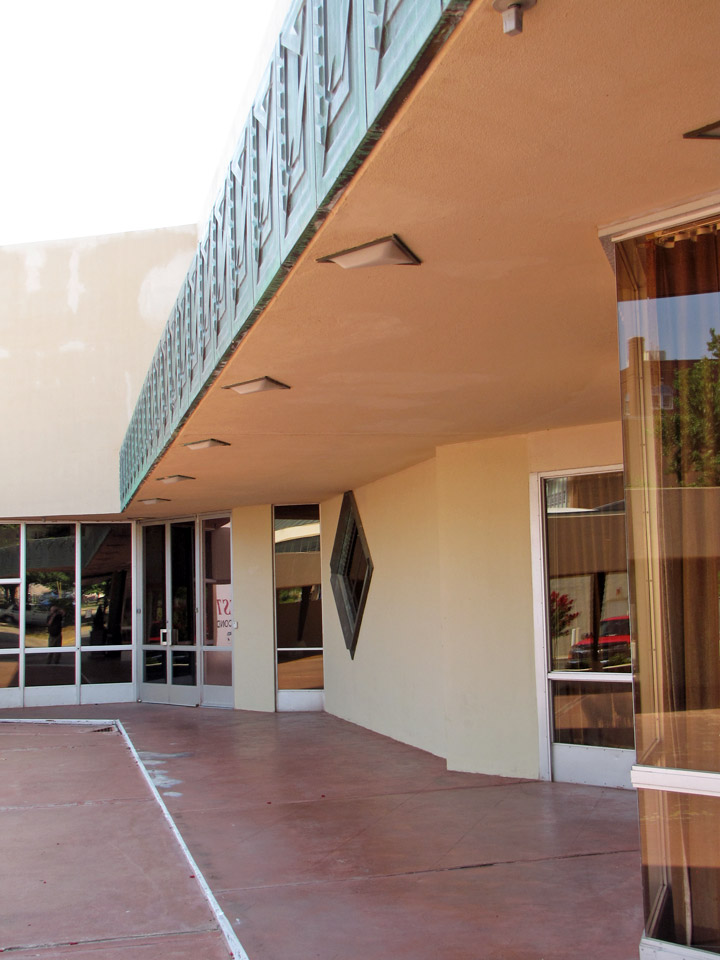
On March 29, 2007, Price Tower was designated a National Historic Landmark by
the United States Department of the Interior, one of only twenty such properties
in the state of Oklahoma. In 2008, the U.S. National Park Service submitted the
Price Tower, along with nine other Frank Lloyd Wright properties, to a tentative
list for World Heritage Status. The 10 sites have been submitted as one, total,
site. The January 22, 2008 press release from the National Park Service website
announcing the nominations states that, "The preparation of a Tentative List is
a necessary first step in the process of nominating a site to the World Heritage
List.
Text from Wikipedia
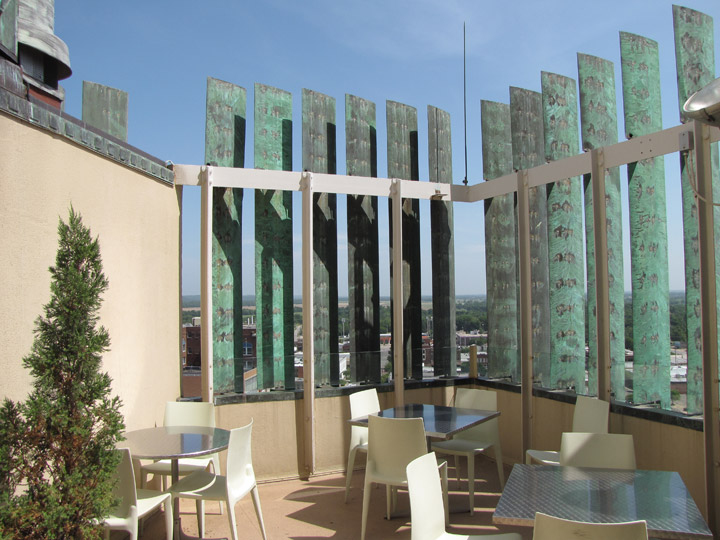
roof terrace
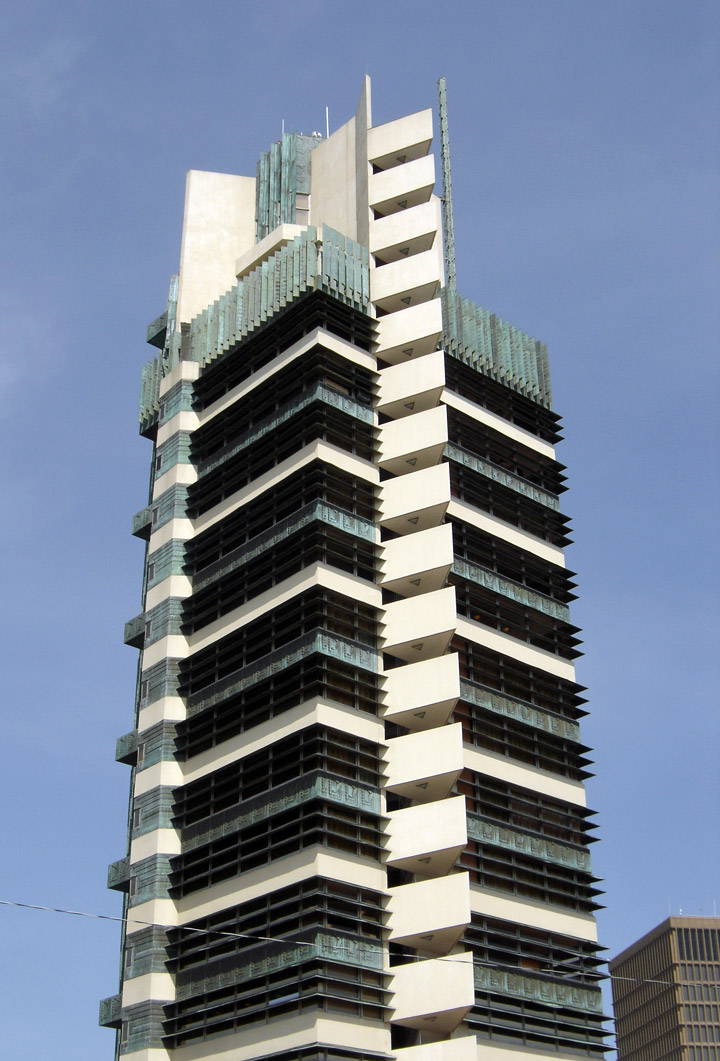
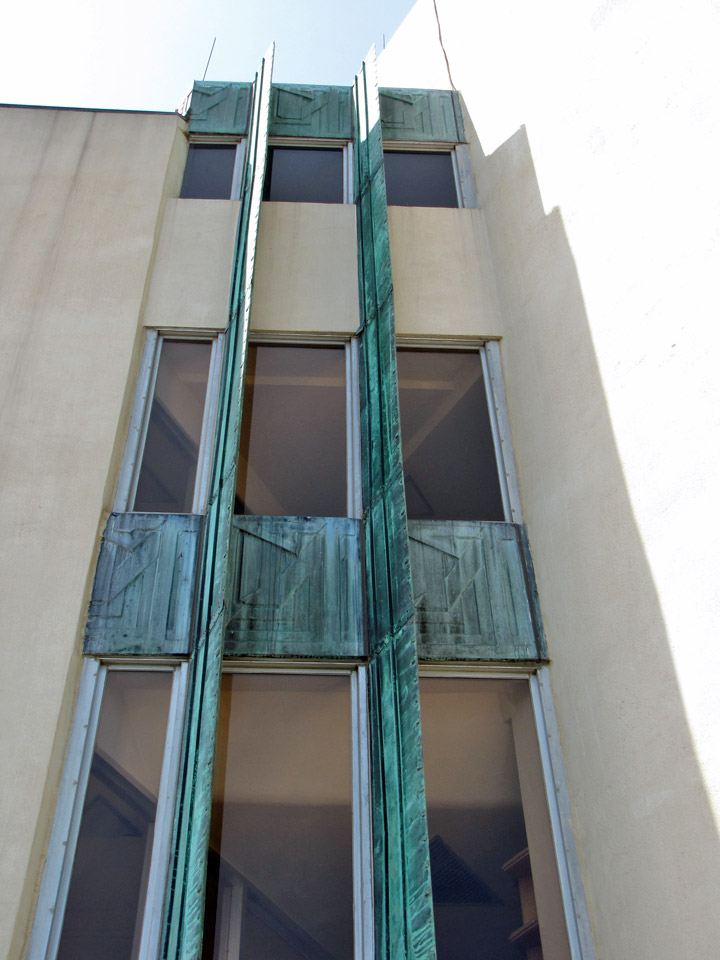
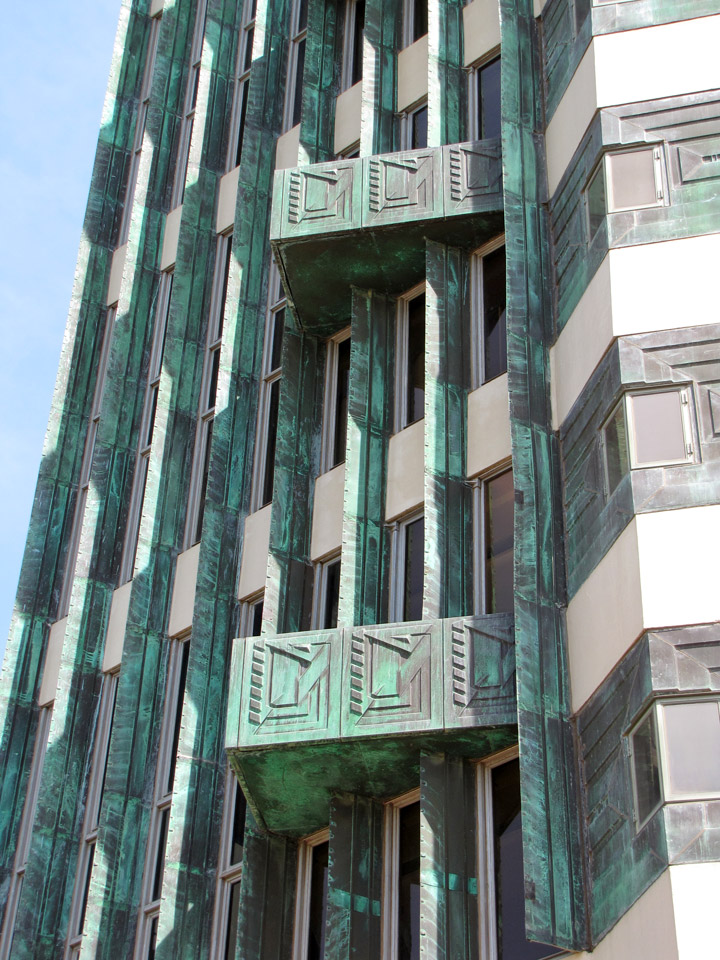
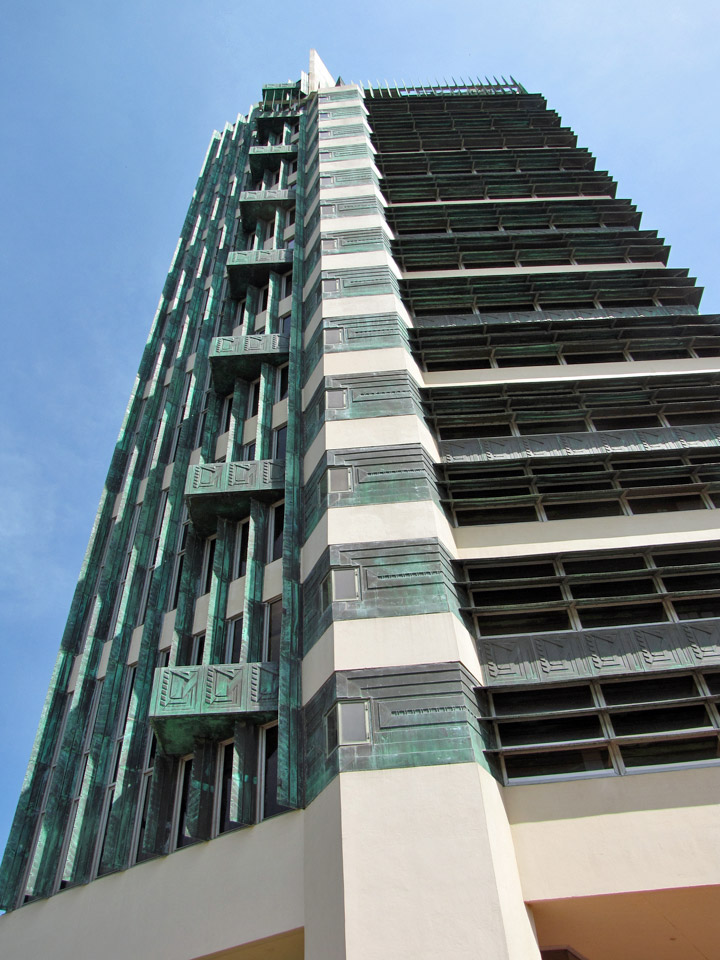
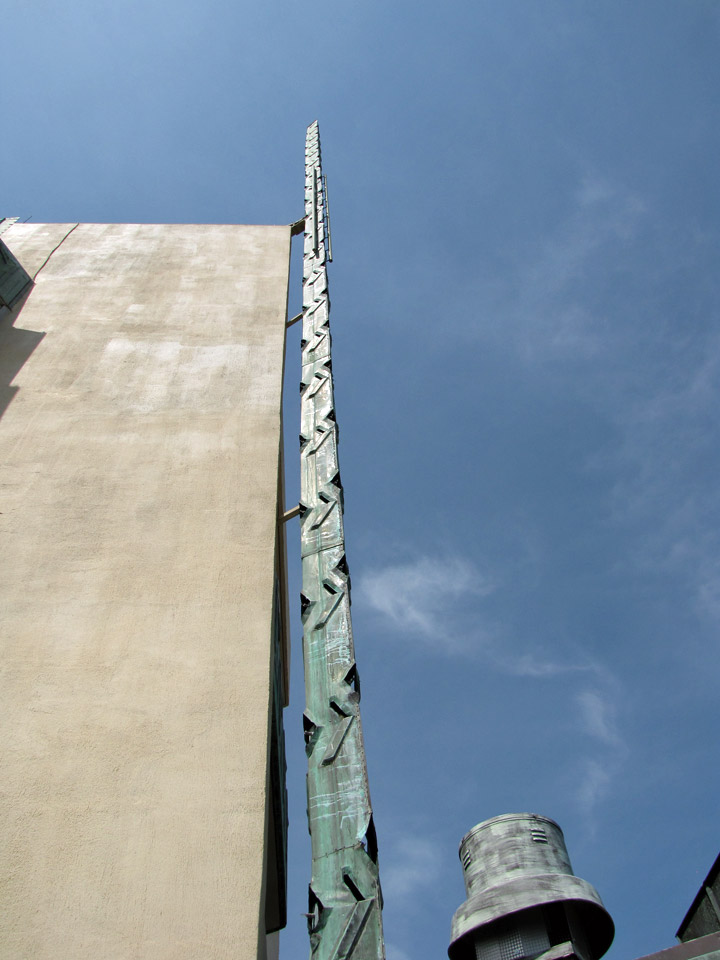
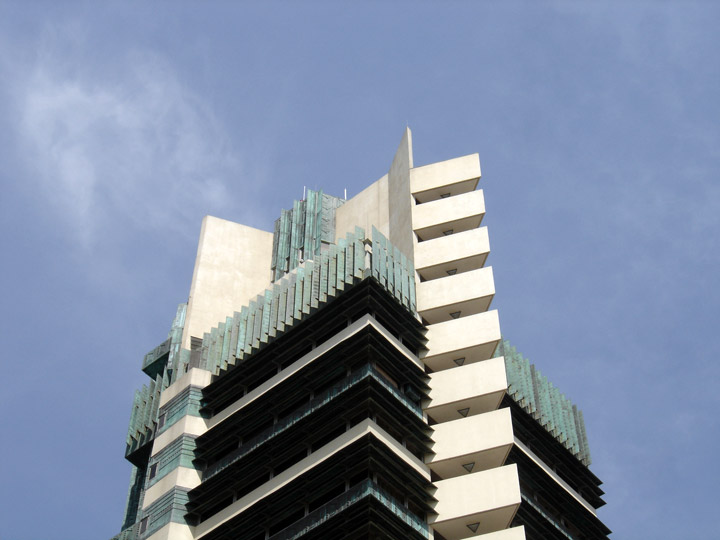
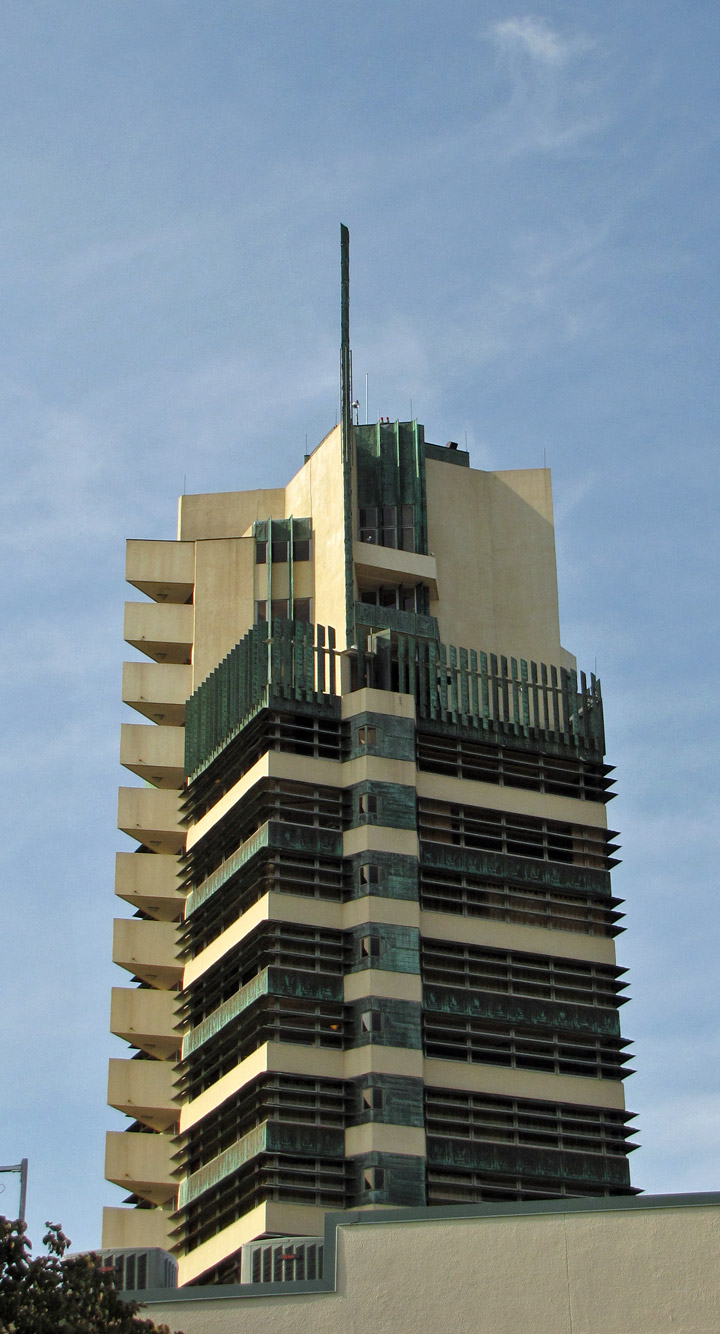
Interior
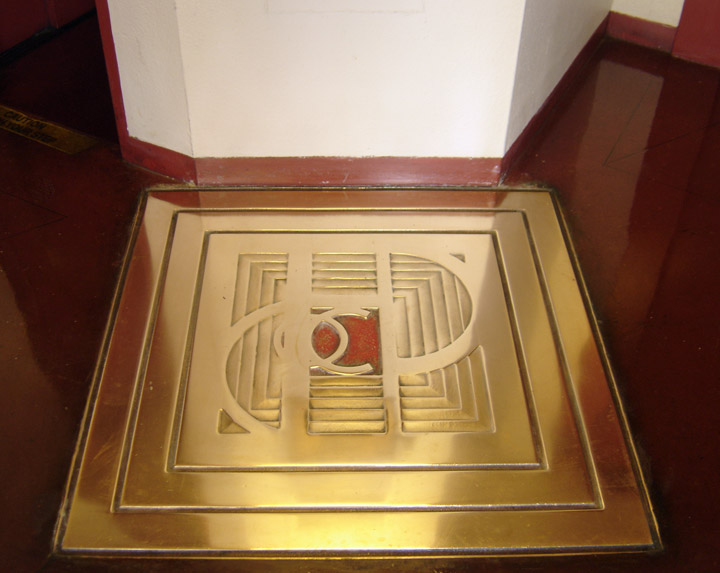
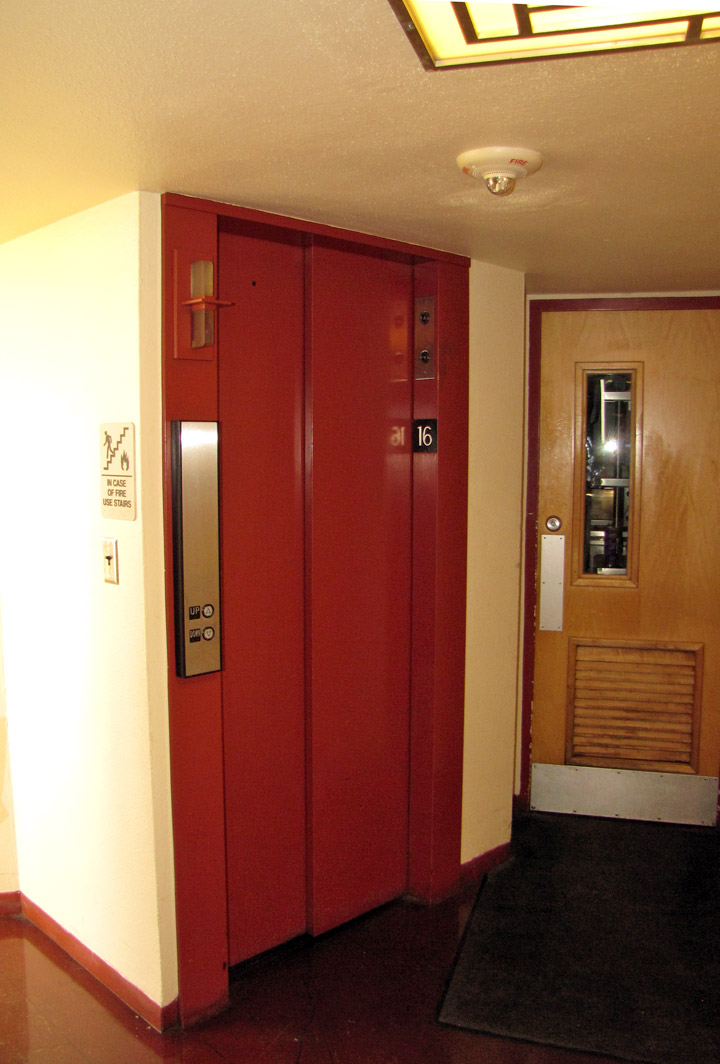
one of three elevators
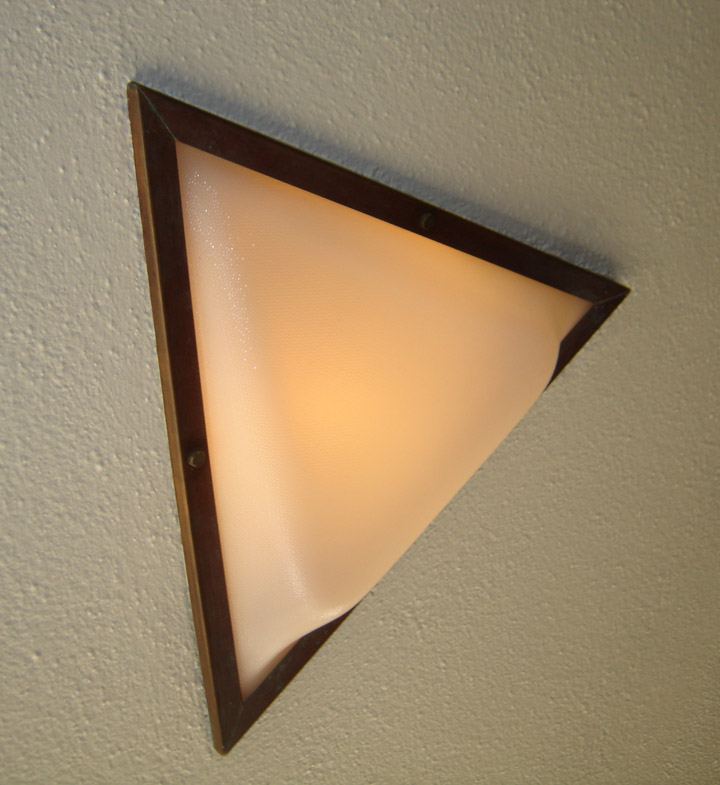
lighting
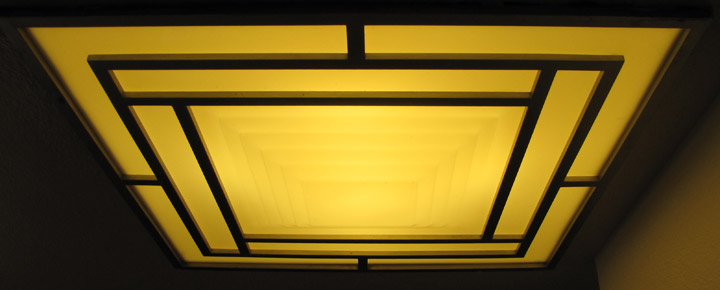
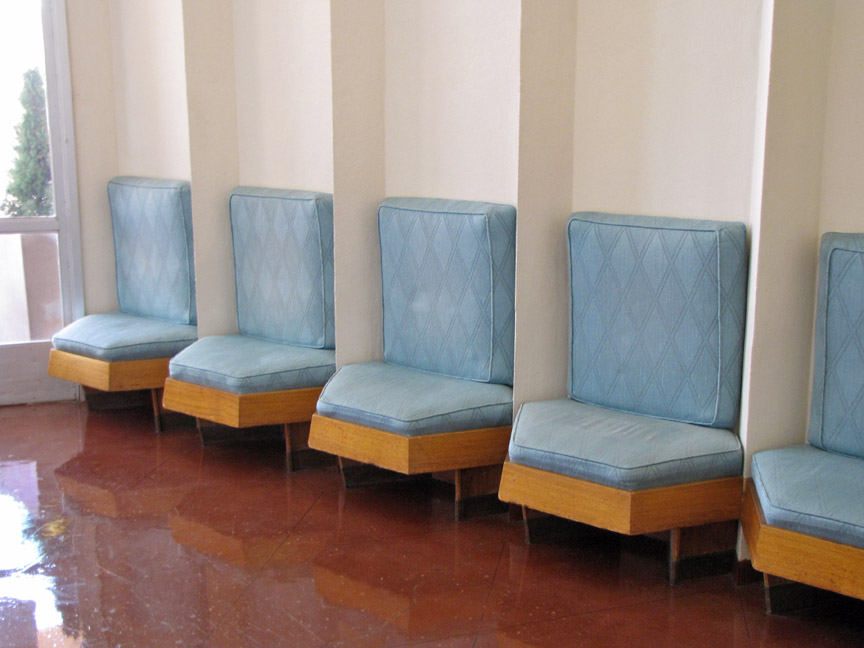
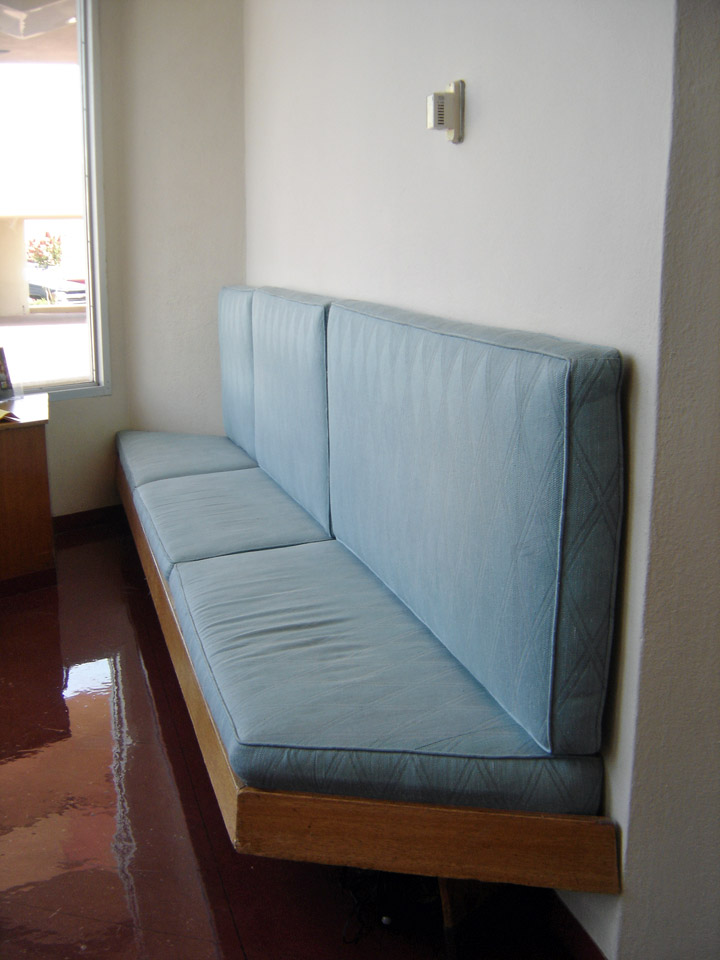
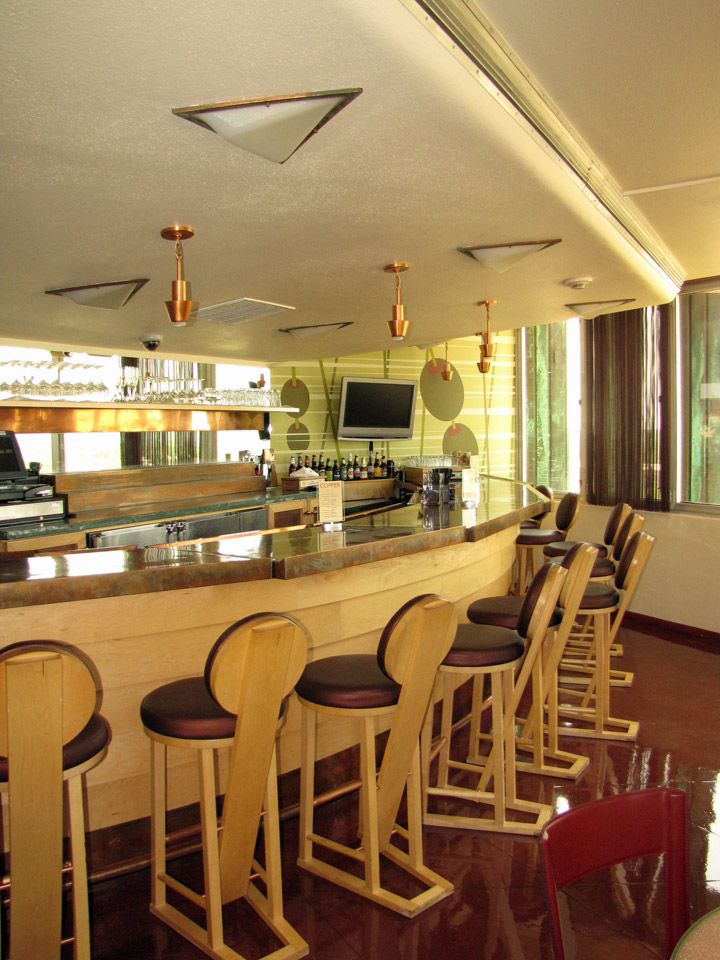
bar on the top floor
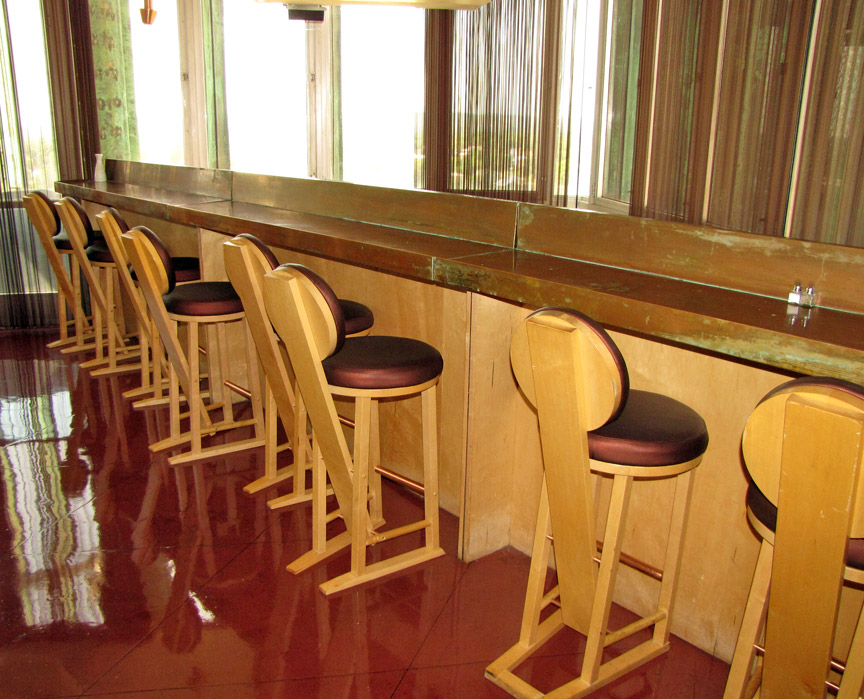
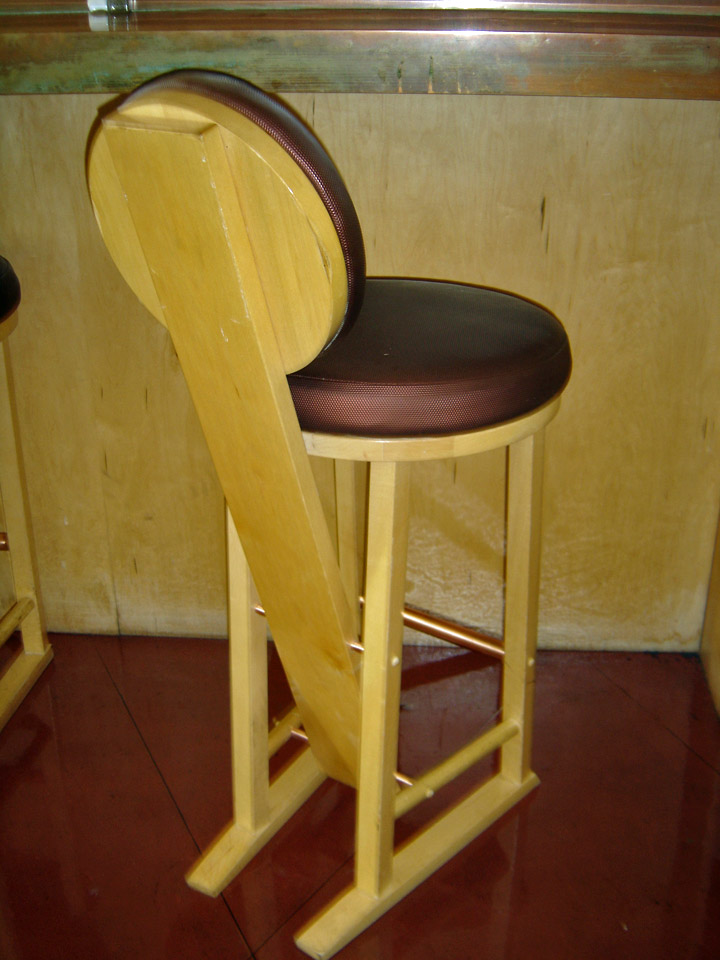
the Wright designed stool
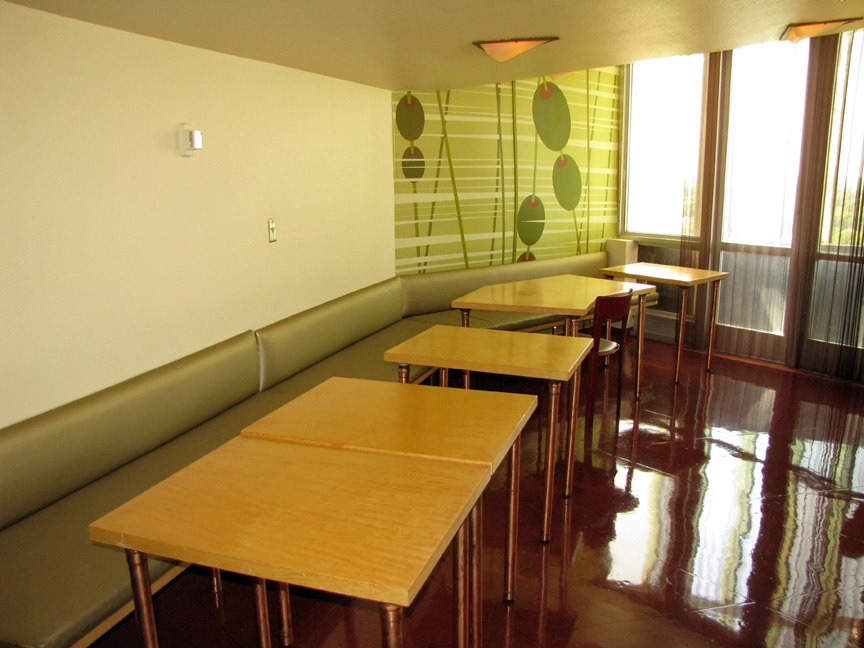

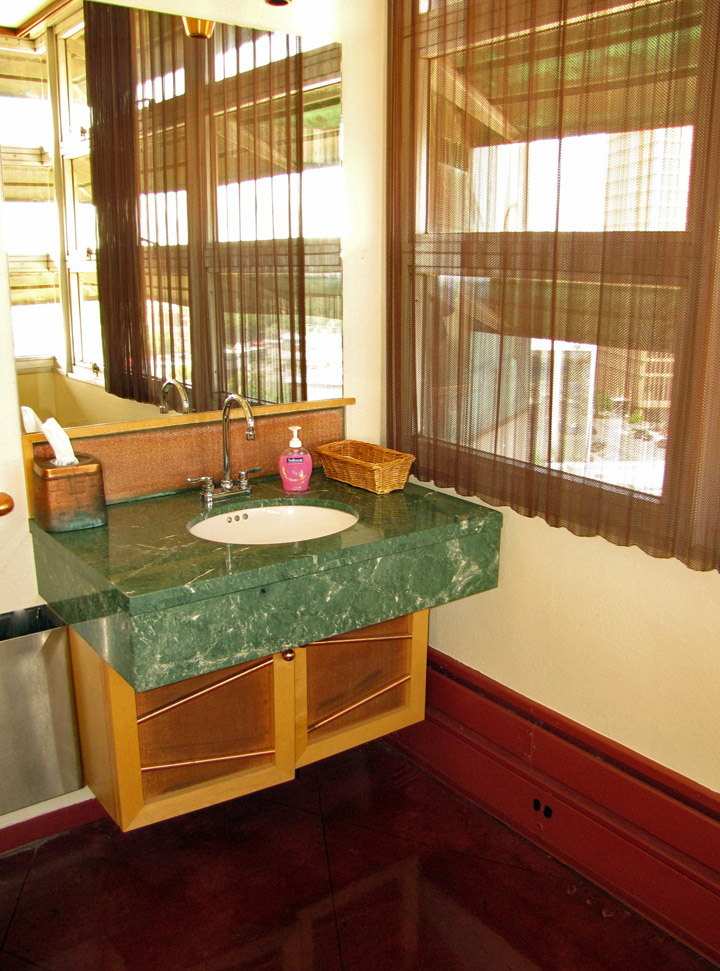
washroom
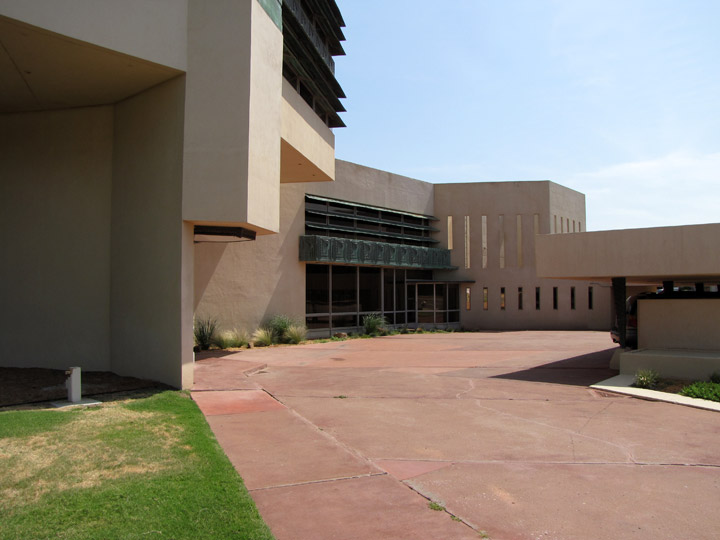
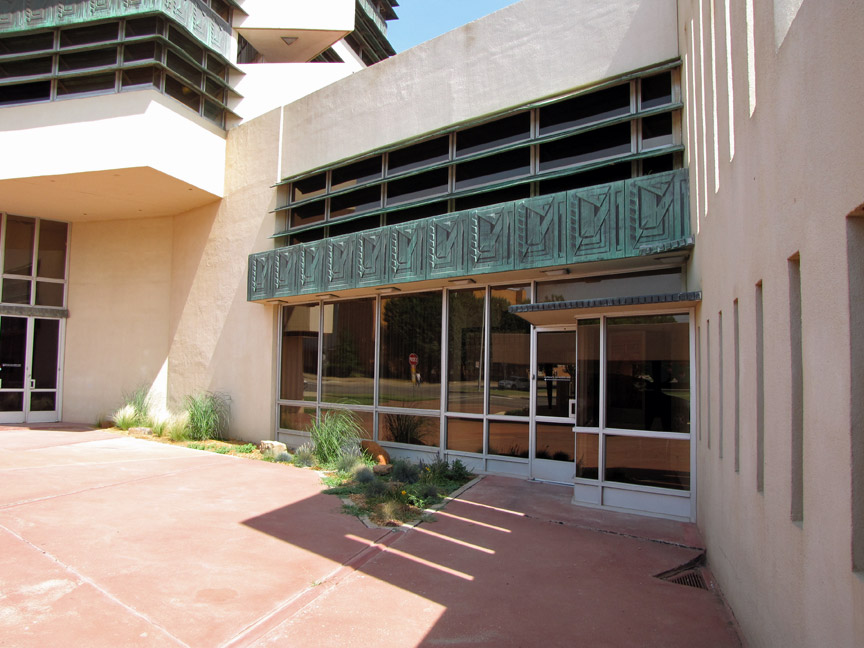
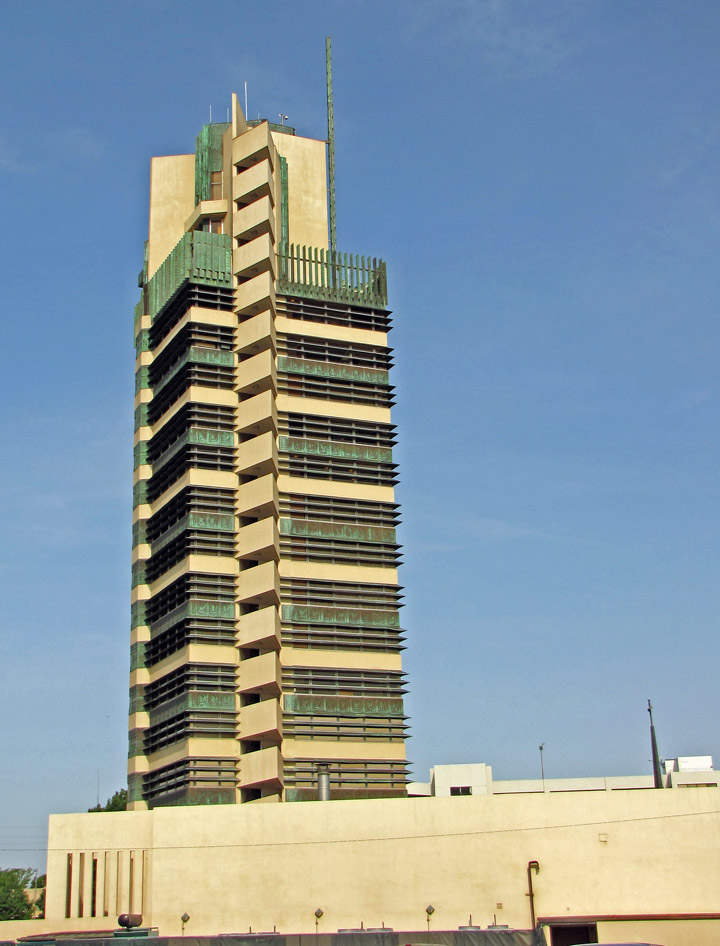
Arts Center added in the foreground

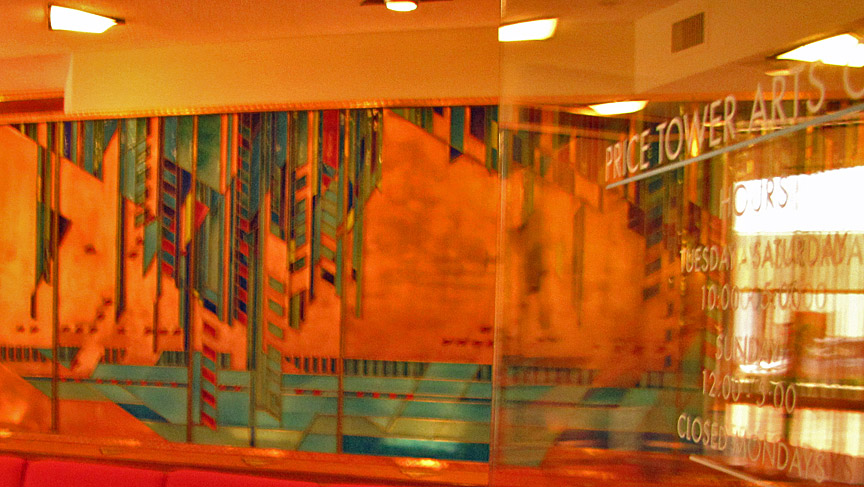
entrance to the Arts Center
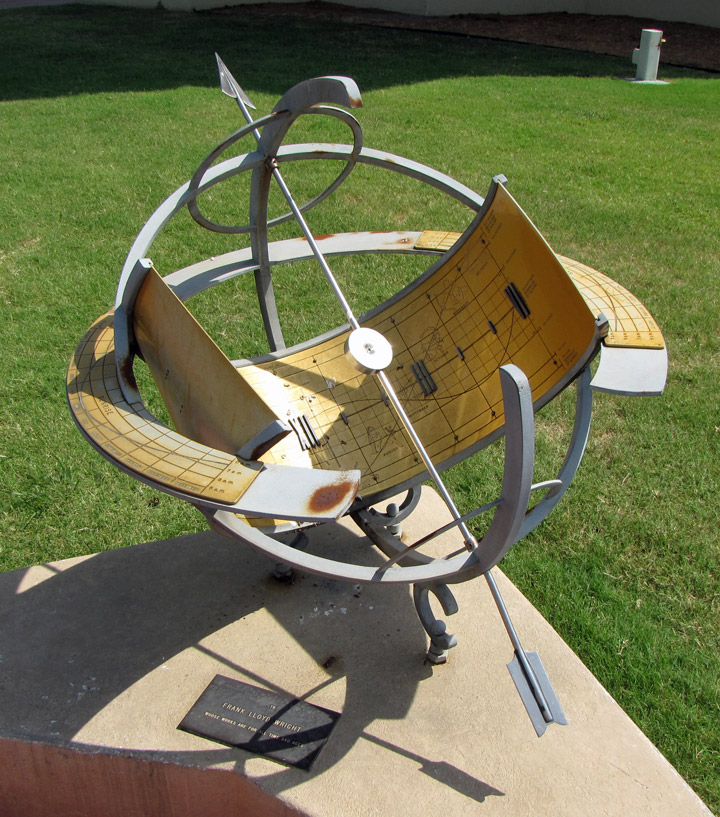
Revisit in 2013
